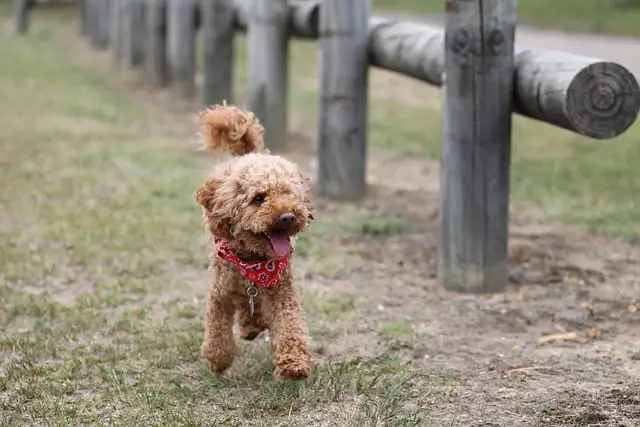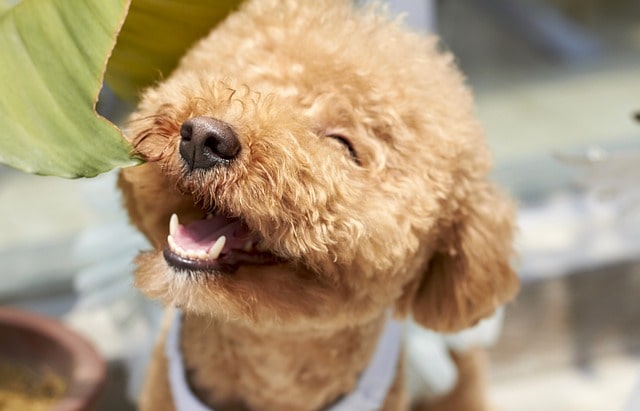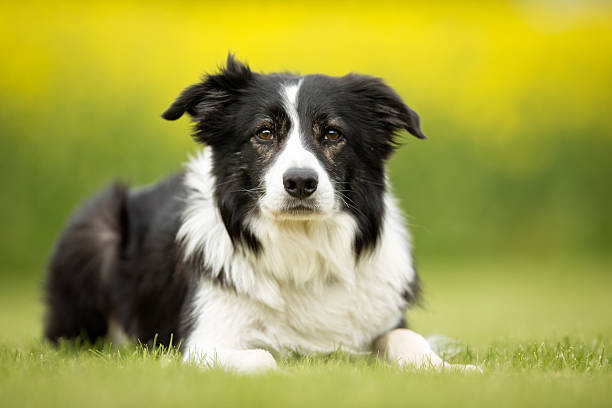Border Collies and Poodles are both excellent choices for pet owners seeking intelligent and versatile companions. They possess several similarities, such as their active nature, low-shedding coats (especially Poodles), and affectionate personalities.
These breeds are known for their high intelligence, which makes them easily trainable and capable of excelling in various activities and roles. Additionally, Poodles are often considered hypoallergenic, which is a significant advantage for individuals with allergies. Moreover, both breeds form strong bonds with their owners, creating a deep sense of companionship.
Characteristics of a Border Collie and Poodle
Border Collies are renowned for their exceptional intelligence and quick learning abilities. They possess a sensitive nature and display remarkable responsiveness to subtle commands, often anticipating their owner’s desires in advance. Not only are they loyal and devoted to their family, but they also excel as watchdogs, displaying a protective instinct towards their loved ones and territory. Border Collies exhibit affectionate behavior towards their family members and typically get along well with children.
To thrive and be content, Border Collies require ample opportunities for mental stimulation and physical activity. They are happiest when engaged in work or play, and without a positive outlet for their abundant energy, they may develop behavioral issues. These remarkable dogs are frequently involved in various canine sports such as:
- Obedience
- Flyball
- Agility
- Tracking
- Flying disc
It’s worth noting that without proper socialization during their early stages of development, Border Collies may become fearful or shy.
Poodles, on the other hand, are recognized for their intelligence, loyalty, and affectionate personalities. They possess a friendly and outgoing demeanor and generally establish positive relationships with people. Alongside their intelligence, Poodles exhibit athleticism, making them excellent companions for active families. Poodles come in three sizes: toy, miniature, and standard, yet they all share similar personality traits.
Poodles are inclined to please their owners and enjoy socializing with others. They thrive when they receive attention and have a remarkable capacity to learn complex behaviors and tricks that demonstrate their intelligence and agility. Poodles maintain a dignified presence and display a cheerful temperament when surrounded by the people they love in a nurturing home environment.
A brief overview of these two dog’s characteristics is shown below:
| Breed | Size | Coat | Exercise requirement | Life expectancy |
|---|---|---|---|---|
| Border Collie | Medium | Straight and flat, Dual-layered coat | Minimum of 1 hour per day | Up to 14 years |
| Poodle | Medium | Hypoallergenic, Coarse and curly | Less than an hour | Up to 15 years |
Breed History
The name “Border Collie” derives from the breed’s prevalence in the English/Scottish border regions, known as the Borderlands. The Border Collie’s unique herding style involves using their intense “eye,” characterized as a fixed and unwavering stare that enables them to control livestock effectively. While the precise history of the Border Collie is undocumented, it is widely accepted that the breed developed through crosses between Roman drover dogs and ancestors of the Finnish Spitz.
As time passed, additional working and sporting breeds such as Beardies, Setters, Pointers, and Sighthounds were also introduced. Throughout its history, the Border Collie has been selectively bred solely for its working prowess and abilities. The breed gained recognition from the Kennel Club in Britain in 1976.
The Poodle, on the other hand, originated in Germany and France. Its name originates from the German term “pudel,” meaning “to splash in water.” Initially, Poodles were bred as water retrievers, accompanying hunters and retrieving waterfowl from bodies of water. The distinct haircuts associated with Poodles were designed to facilitate swimming while keeping the dogs warm.
Poodles also served various roles, including circus performers, war dogs, and even truffle hunters. The toy and miniature variations of Poodles emerged during the 17th and 18th centuries, possibly due to the appeal of carrying small dogs around as companions.
In 18th century Spain, Poodle was the preferred pet dog, as depicted in the works of Francisco Goya, a renowned Spanish artist. While commonly believed to be of French origin, the Poodle’s roots can be traced back to curly-coated dogs from central Asia. The breed was officially recognized by the American Kennel Club in 1887, becoming one of the earliest registered dog breeds.
Appearance Comparison
The Border Collie is a medium-sized herding dog known for its strong and agile body, which is supported by a lean frame. This breed possesses a double coat that can range from smooth to rough, occasionally displaying curls. The coats, both rough and smooth, come in various colors and patterns, adding to the breed’s visual diversity.
Border Collies have distinctive ears that stand upright, but their tips fold over, giving them a lively and jaunty appearance. Their alertness is further emphasized by their ears perched high on their heads, often partially folded at the tip. Unlike some working breeds, Border Collies have long and bushy tails that are in constant motion, expressing their wagging enthusiasm.
Poodles, on the other hand, have a square-shaped outline with a gracefully elongated neck and a straight back. They tend to exhibit a leggy appearance accompanied by a long muzzle. Poodles possess dropped ears that are set at or below eye level, gracefully hanging down. Their eyes are oval-shaped and dark in color.
The Poodle’s most recognizable feature is its distinctively thick and curly coat, which comes in an array of colors and patterns. However, it’s important to note that breed registries generally recognize only solid colors in Poodles.
Both the Border Collie and the Poodle have distinct physical characteristics that contribute to their unique appearances, highlighting their individual breed traits.
Size Comparison
Border Collies typically fall into the medium-sized category, with an average height ranging from 22 to 27 inches (56 to 69 cm) at the shoulder. The withers height, which is the highest point of the shoulder blades, generally ranges from 18 to 22 inches (46 to 56 cm). In terms of body length, Border Collies typically measure between 28 and 34 inches (71 to 86 cm).
Poodles, on the other hand, are available in three distinct sizes:
- Toy Poodle: This category includes Poodles that are 10 inches (25 cm) or shorter at the shoulder. They typically weigh between 4 and 6 pounds (2 to 3 kg).
- Miniature Poodle: Miniature Poodles are taller than 10 inches (25 cm) but not exceeding 15 inches (38 cm) at the shoulder. Their weight ranges from 15 to 17 pounds (7 to 8 kg).
- Standard Poodle: The Standard Poodle is the largest size category, standing over 15 inches (38 cm) at the shoulder. Most Standard Poodles fall within the range of 22 to 27 inches (56 to 69 cm). They weigh between 50 and 70 pounds (23 to 32 kg).
It’s worth mentioning that there are additional variations of Poodles, such as the moyen or Klein Poodle, which is slightly smaller than the Standard size but not universally recognized by all kennel clubs. Additionally, there are teacup Poodles that are even smaller, but they have not yet gained recognition from breed registries.
Coats & Colors
Border Collies showcase a diverse array of colors and patterns, categorized as either standard or non-standard as per the American Kennel Club (AKC). The standard colors include lilac, black, white and black, red, gold, red merle, blue, blue merle, and white and blue merle while the non-standard colors are seal, white and sable, slate, white and seal, and white and gold. These colors adhere to the AKC’s recognized standards for Border Collies.
While it is uncommon for Border Collies to have a solid color, they typically display bicolor, tricolor, sable, merle, ticked, or speckled patterns. Additionally, there are some rare colors in Border Collies such as slate, brindle, and blue, which deviate from the more commonly seen black and white or red and white colorations.
Poodles also come in a variety of colors, including both solid and multi-colored coats. The most prevalent solid colors for Poodles are black, white, brown, and blue. Other solid color options include silver, silver beige, cream, apricot, and red. Poodle coats can also feature multi-coloration, with combinations of two or more colors. Multi-colored Poodles exhibit patterns such as parti, phantom, and sable. It’s important to note that certain colors, such as white, are more prevalent, while others, like silver beige, are considered rare.
Personality & Temperament Difference of a Border Collie and Poodle

Border Collies are widely recognized for their exceptional intelligence and possess a range of distinct personality traits. Some of these characteristics include:
- Strong work ethic: Border Collies have a natural drive to work and excel when given mental and physical challenges. They are happiest when engaged in tasks or play that provide them with a constructive outlet for their energy.
- Herding instincts: Border Collies have a natural inclination for herding, which extends to being protective of their family and territory. They make excellent watchdogs and may attempt to herd children, vehicles, or other animals in the absence of sheep or a specific task.
- Sensitivity and responsiveness: Border Collies are highly sensitive and responsive. They possess an innate ability to pick up on even subtle cues and anticipate the needs of their owners.
Similarly, Poodles have their own unique personality traits that set them apart from other breeds. These characteristics include:
- Devotion: Poodles are known for their deep devotion and quickly form close bonds with their family members. They have a strong sense of empathy and strive to win over the affection of their loved ones.
- Playful and lively nature: Poodles have a playful and lively demeanor. They enjoy engaging in games and activities that stimulate their curiosity, as they thrive on attention and mental stimulation.
- Dignified and joyful temperament: Poodles exhibit a sense of dignity and carry themselves with grace, particularly when surrounded by their loved ones in a comfortable home environment. They display a joyful temperament that reflects their contentment and happiness.
Both Poodles and Border Collies are beloved companions, each with their own distinct qualities. Their unique personality traits contribute to their individuality as breeds and make them cherished companions for those who appreciate their special qualities.
Dogs towards Family
Border Collies are celebrated for their friendly and loyal nature towards their family members. They eagerly befriend not only humans but also other dogs and certain farm animals. They possess a perceptive nature, attuned to body language and moods, allowing them to understand and respond to their owners’ emotional states.
Affection is a prominent trait in Border Collies. They display their love and care by seeking cuddling and physical contact. Affectionate behavior serves purposes such as stress relief, protection of their owners, and maintaining warmth when they feel cold. However, it is important to note that Border Collies require significant time and attention from their owners. Without proper training and exercise, they can easily become bored, unhappy, and challenging to manage.
Poodles, in general, are recognized as good family dogs. They possess a friendly, energetic, and playful nature, making them well-suited for families with active children. It should be noted that among the different sizes of Poodles, only the standard Poodle is typically considered a suitable family dog. Miniature Poodles tend to have a more high-strung temperament and may not be as compatible with families with children.
Kids
With adequate training and supervision, many Border Collies can successfully integrate into family settings. Teaching the dog to recognize that children are friendly and establishing clear boundaries can help discourage herding behaviors. It is crucial to establish household rules and closely supervise interactions between the dog and children to foster a harmonious relationship.
When introducing a new Poodle into a household with young children, it is important to supervise their interactions and ensure that children are taught to treat the dog with respect and gentleness. It is essential to recognize that each individual dog has their own unique personality and preferences. Taking the time to understand and respect the Poodle’s specific likes and dislikes will contribute to a harmonious and safe environment for both the dog and the children.
Other People
While Border Collies are generally not aggressive by nature, there are certain situations where they may display aggression towards other people or dogs. Here are some possible reasons for Border Collie aggression towards other people:
- Pack Mentality: Border Collies have a pack mentality, and they may exhibit aggression if they feel that they are not receiving enough attention or if they perceive someone else, such as a guest or another pet, as a potential threat to their bond with their owner.
- Dominance Aggression: In some cases, a Border Collie may develop dominant behavior and aggression if they feel the need to establish dominance over their owner or others in the household.
- Resource Guarding: Border Collies may show aggression to protect their possessions. This can manifest as defensive body language, growling, snapping, or even biting to keep others, including people or other dogs, away from their valued items.
If early signs of aggression are observed in a Border Collie, it is crucial to take immediate action and seek assistance from a professional behaviorist or trainer to address and manage the aggression.
As with Poodles, they are generally friendly and loyal dogs that get along well with kids and other animals. However, like any breed, Poodles can exhibit aggressive behavior in certain situations. Here are a few potential reasons why a Poodle might display aggression towards other people:
- Anxiety: Poodles can develop anxiety, which may lead to aggressive behaviors. When they feel anxious, they may become fearful and perceive everyone as a potential threat or enemy. Poodles can also experience separation anxiety when they are separated from their owners for extended periods.
- Territorial Aggression: Poodles exhibit aggression towards strangers whenever they feel that their domains are being intruded as they perceive it as danger to their living space.
It is important to note that Poodles are highly people-oriented and eager to please. Proper training, socialization, and addressing any underlying anxiety or behavioral issues can help prevent aggression in Poodles. Seeking guidance from a professional trainer or behaviorist can be beneficial in addressing aggression-related concerns.
Dogs & Other Animals
To maintain friendly interactions between your pet dog and other animals, here are some helpful tips to follow:
- Start in a calm, neutral environment: Begin the process in a controlled setting with minimal distractions or stimuli that could provoke anxiety or aggression in your dog.
- Introduce with a familiar, well-behaved dog: When initiating the introduction, ensure that both dogs are properly leashed. Initially, keep a distance between your dog and the other dog, rewarding your dog for displaying calm behavior. Gradually approach the other dog while monitoring their reactions. Allow the dogs to sniff and circle each other if they appear comfortable. Eventually, walk away with your dog.
- Utilize positive reinforcement: Depending on your dog’s level of shyness or fearfulness, you may need to repeat the introduction process multiple times for them to become comfortable with other animals. Use treats and verbal praise to reward your dog for remaining calm and exhibiting positive behavior during interactions.
- Observe body language: Pay close attention to the body language of both dogs. Look for signs of defensiveness or wariness, such as raised hair on the back, bared teeth, growling, a stiff-legged gait, or prolonged staring. If you notice any of these postures, whether at a distance or during close proximity, calmly and promptly interrupt the interaction.
By following these guidelines and monitoring your dog’s behavior and responses, you can foster and maintain friendly relationships between your pet and other animals. If needed, consult with a professional dog trainer or behaviorist for further guidance and assistance.
Behavior Issues
Lack of appropriate training or consistent mental stimulation can lead to the development of behavioral problems in Border Collies. These problems may manifest in various ways, such as engaging in herding behaviors and nipping at the heels of both children and adults.
Additionally, they may exhibit destructive habits like chewing objects or digging. When Border Collies become bored or frustrated, they tend to resort to excessive barking as a means of expression. Therefore, it is crucial to provide them with proper training and mental stimulation to prevent these issues from arising.
A significant factor contributing to these problems is the mismatch between the dog’s natural instincts and the environment it is kept in. Border Collies, for instance, possess strong herding instincts, which may result in them instinctively herding adults, particularly young children, by playfully nipping at their heels. Although this behavior is innocent in nature, it can evoke fear and concern among younger children and their parents.
A key preventive measure against behavioral issues in Border Collies is to ensure they receive sufficient exercise and mental stimulation. Engaging them in activities like games and playtime can be beneficial, but they also derive great enjoyment from more physically demanding pursuits like agility, flyball, or herding competitions.
Poodles can have behavioral issues. Some of these issues can be anything from stubbornness, aggression, anxiety, sensitivity, or shyness.
- Stubbornness: Poodles have a tendency to be stubborn and may be challenging to train, especially if they lack sufficient mental stimulation.
- Aggression: Improper socialization can lead Poodles to exhibit aggression towards strangers or other dogs. They may also try to assert dominance over people and other canines.
- Anxiety: Poodles are prone to developing anxiety, which can manifest as aggressive behavior. They are also susceptible to separation anxiety when separated from their owners for extended periods.
- Sensitivity: Poodles possess a sensitive nature, which can be a significant behavioral challenge. They can easily startle in response to sudden noises, rough handling, or a noisy environment. Without delicate handling, they may develop undesirable behavioral traits.
- Shyness: Poodles often display shyness when encountering unfamiliar people. Additionally, they can be highly strung and require ample mental stimulation and exercise to maintain a balanced temperament.
Training & Exercise

Exercise is indeed crucial for the overall well-being of dogs, including Border Collies and Poodles. Both breeds require regular physical activity to stay healthy and mentally stimulated. Here are some reasons why training and exercise are important for these breeds:
- Physical fitness: Regular exercise help these dogs to maintain a healthy weight, improve muscle tone, and support overall cardiovascular health.
- Mental stimulation: Poodles and Border Collies are highly intelligent and benefit from mental challenges. Engaging in training sessions, puzzle toys, and interactive play can keep their minds active and prevent boredom.
- Energy release: Both dogs have varying energy levels depending on their size, but all require exercise to release energy and prevent restlessness. Regular exercise can help reduce hyperactivity and promote a calm and contented demeanor.
- Behavior management: Sufficient exercise helps release pent-up energy, reducing the likelihood of behavioral problems such as excessive barking, digging, or chewing. It can also prevent separation anxiety and promote better behavior overall.
It is essential to provide appropriate exercise for both Border Collies and Poodles while being mindful of their individual needs and limitations. Overexercising, especially in hot weather, can be harmful to any dog.
It’s important to recognize the signs of fatigue or overexertion and adjust the intensity and duration of exercise accordingly. Always consult with a veterinarian to determine the right exercise regimen for your specific dog, taking into consideration their age, health condition, and individual requirements.
Taking Care & Maintenance of a Border Collie and Poodle
Proper care and maintenance of your Border Collie or Poodle involve several important steps to ensure their well-being. Here are some key aspects to consider:
- Provide a balanced diet: Offer your dog a healthy and nutritious diet to support their overall health. Ensure they have access to fresh drinking water at all times.
- Create a safe living environment: Your dog requires a safe and clean-living space that is free from potential hazards. Take necessary precautions to remove any dangerous objects or substances that could harm your dog. Regularly inspect and maintain the cleanliness of their living area.
- Regular veterinary check-ups: Consulting your trusted vet can provide you well-rounded care for your pup since they have the expertise to determine health issues as well as to provide you with a dietary plan based on your dog’s breed, age, activity levels, and size.
- Clean and maintain bathroom areas: Whether your pet uses an indoor or outdoor bathroom, clean it regularly to prevent the accumulation of dirt and bacteria, which can impact your pet’s health.
- Emergency preparedness: Have a plan in place for emergencies. Create a list of important information about your dog’s routine, including feeding schedules, medication details, and your vet’s contact information. Share this information with someone you trust, ensuring they can care for your dog if you are unavailable during an emergency.
Grooming Comparison between Border Collie and Poodle

Border Collies have a double coat, with the guard coat being longer than the undercoat. Grooming them every 4-8 weeks, with increased frequency during shedding seasons, is necessary. However, regular trims are typically not required if you maintain a consistent brushing routine to prevent tangling and matting. You can do the following when doing a DIY grooming of your dog.
- Brushing: Three times a week will help to reduce tangles on your Border Collie’s coat. You would like to do it daily on shedding seasons. This practice can help keep your dog’s coat in great condition.
- Bathing: Border Collies generally need bathing every 2-3 months or as needed. Use a balanced dog shampoo instead of human shampoo to avoid any skin issues.
- Trimming: Trimming your Border Collie’s coat is relatively simple once you become familiar with it. Focus on tidying up any noticeable knots and mats, being cautious not to trim too much hair.
When it comes to grooming Poodles, the cost can vary based on factors such as the dog’s size, coat condition, desired haircut, and location of the groomer. Here are some examples of grooming prices for Poodles:
- Toy Poodle: No haircut typically ranges from $30 to $50, while a full groom or bath and brush + haircut can cost $50 to $60.
- Miniature Poodle: For a breed bath ‘n brush, prices usually range from $35 to $60, and a full groom can be around $55.
- Standard Poodle: A breed bath ‘n brush is typically priced around $60, while a full groom may cost around $80.
- All Poodles: Standard poodle grooming costs can range from $50 to $120, depending on the specific location and desired type of cut.
Shedding
Border Collies have two primary shedding seasons, which occur in Spring and Autumn. During these times, they shed excessively, requiring regular and thorough grooming to manage the shedding. Brushing your Border Collie two to three times a week is typically sufficient to remove dead hair and minimize shedding. Additionally, using anti-shed shampoos specifically designed for dogs can help control and manage shedding.
On the other hand, Poodles have a different shedding pattern compared to many other breeds. They experience light hair loss throughout the year, and their individual curly hair strands tend to coil together as they shed. This characteristic of their coat helps minimize the visibility of shed hair around the home. Poodles are not considered seasonal shedders, and their shedding frequency is generally lower due to having hair rather than fur.
Unlike fur, Poodle hair consistently grows rather than falling out. Furthermore, Poodle hair is often considered hypoallergenic, meaning it is less likely to trigger allergies in individuals sensitive to pet dander.
Health Comparison between a Border Collie and Poodle
Border Collies are generally considered a healthy breed, known for their athleticism and agility. However, their high energy levels necessitate ample exercise and mental stimulation to ensure their overall health and happiness. Regular checkups with a veterinarian are crucial in identifying and addressing any potential health issues, promoting a longer and more fulfilling life for your Border Collie.
Similarly, Poodles are generally known to be a healthy breed with minimal health concerns. Nevertheless, like all dog breeds, Poodles may be prone to certain health problems, common to all dogs and specific to the breed.
It’s important to understand that not all health conditions can be detected during a dog’s growth stage, and it can be challenging to predict a pet’s future health. However, responsible breeders are committed to breeding the healthiest dogs possible and may provide certifications demonstrating that the dog’s parents and grandparents have undergone screenings for various defects. To ensure the well-being of your pets, it is essential to provide them with proper nutrition, regular exercise, and routine veterinary care.
Life Span Comparison
Border Collies are generally healthy dogs with an average lifespan ranging from 12 to 15 years. However, it’s worth mentioning the exceptional case of Bramble, one of the oldest Border Collies on record, who lived an impressive 25 years before passing away.
The lifespan of Poodles, like any other breed, can vary based on factors such as size and overall health. On average:
- Toy Poodles typically live between 12 to 16 years.
- Miniature Poodles have an average lifespan of 14 to 17 years.
- Standard Poodles generally live around 12 to 15 years.
It’s important to remember that these figures are average estimates and individual Poodles may live longer or shorter lives depending on various factors, including their overall health, genetics, and the level of care they receive throughout their lives. Regular veterinary checkups, a balanced diet, exercise, and a nurturing environment can all contribute to a Poodle’s longevity and well-being.
Diet & Nutrition
Feeding a Border Collie or a Poodle a balanced and appropriate diet is crucial for their overall health and well-being. Here are some key points to consider when it comes to feeding these breeds:
For Border Collies:
- Raw Food Diet: Some owners opt for a raw food diet for their Border Collies, which typically consists of a combination of meat, bone, offal, and a small amount of plant ingredients. This diet aims to replicate what dogs would eat in the wild, providing beneficial vitamins and minerals.
- Balanced Diet: A balanced diet for Border Collies includes high-quality protein, healthy fats, vitamins, minerals, and fiber from vegetables and berries.
- Protein and Fat: Border Collies benefit from a diet that is rich in protein, considering their active lifestyle, size, and muscle mass. Protein sources should primarily come from real meat. Of course, there are other sources where it can be acquired such as peas, spinach, and pea protein can also contribute to their nutritional needs.
- Vegetables and Fruits: Including vegetables and fruits in a Border Collie’s diet is beneficial. Opt for those high in antioxidants and vitamins, such as raspberries, carrots, peas, and more.
For Poodles:
- High-Quality Protein: Poodles thrive on a high-quality diet that is rich in protein. Chicken, turkey, beef, duck, fish, and pork are excellent protein sources that provide vital nutrients to support their overall health.
- Grains, Fruits, and Vegetables: Including grains, fruits, and vegetables in a Poodle’s diet can provide additional nutrients. Rice, pumpkin, apple, peas, and carrots are some examples of beneficial ingredients.
It’s important to note that while homemade diets can be considered, it can be challenging to ensure the proper balance of nutrients. Consulting with a veterinarian is recommended to customize a healthy and balanced diet plan for your Poodle or Border Collie, taking into account their specific needs, life stage, and any potential dietary restrictions or health concerns.
Health Issues
Border Collies and Poodles, like any other dog breeds, have their own set of health concerns. It is important to be aware of these issues to ensure the well-being of your furry companions. Common health problems that Border Collies may encounter include hyperthyroidism, epilepsy, hip dysplasia, and bacterial infections. Similarly, Poodles are also susceptible to various health issues, especially if they are not properly cared for. Some of these ailments include thyroid problems, bloating, Sebaceous Adenitis, Addison’s disease, and among others.
Naturally, as a dog owner, you would want to prevent these health problems from affecting your beloved pets. Fortunately, there are several measures you can take to safeguard their health and keep them free from illnesses. To help you out, we have compiled a list of general tips that can be applied to your dog’s care routine, ensuring their overall well-being and minimizing the risk of health complications.
- Keep up with vaccinations: Vaccines are important for protecting your pet against infectious diseases. Consult with your veterinarian to ensure your pet receives the necessary vaccinations.
- Use preventive medications: Discuss with your vet about using appropriate preventive medications, such as those for fleas, ticks, and heartworms, to keep your pet protected.
- Regularly check your pet: Conduct routine checks for any signs of illness or injury, such as lumps, skin issues, or changes in behavior. Promptly address any concerns with your veterinarian.
- Schedule routine vet visits: Regular veterinary check-ups are crucial for detecting and addressing health issues early on. Follow your vet’s recommendations for wellness exams and preventive care.
- Provide a balanced diet: Feed your pet a nutritious and balanced diet suitable for their specific needs and life stage. Avoid overfeeding to prevent obesity and associated health problems.
Remember, each dog is unique, and their specific health concerns may vary. Regular communication and collaboration with your veterinarian are essential for maintaining your pet’s health and well-being.
Comparing Cost
The price of a Border Collie puppy can range around $700 on average. However, several factors can influence the price, such as whether the puppy is a mixed breed or purebred, and whether it’s considered show-quality. Additionally, factors like age, gender, pedigree, breeder’s location, and coat color can also impact the price. Blue merle Border Collies, for example, can command higher prices, sometimes reaching up to $4,500.
Similarly, the cost of purchasing a Poodle can vary depending on factors such as size, breeder reputation, pedigree, and location. Prices generally range from about $500 to $2,000 or more.
In addition to the initial buying cost, it’s important to consider other expenses associated with owning a Border Collie or Poodle. These include vaccinations, diet, healthcare, grooming, and toys. Regular veterinary visits are essential for maintaining your dog’s health, with an estimated budget of around $500 per year recommended by the American Kennel Club. Additionally, acquiring a Poodle can cost up to $2,000, and initial expenses for care and supplies can amount to $1,000 or more. Monthly expenses for food, grooming, and other supplies can add up to around $100 or more.
Puppies

If you are preparing to bring a Border Collie or a Poodle puppy into your family, there are several essential items you should consider purchasing to ensure their well-being and happiness. These items are generally applicable to all dog breeds. Here are some of the key items recommended for a new puppy:
- Collar and Leash: Essential for walks, outings, and keeping your puppy safe during outdoor activities.
- Crate: A crate provides a safe and secure space for your puppy to sleep, rest, and aid in potty training.
- Dog Bed: A comfortable dog bed gives your puppy a designated and cozy spot to rest and sleep.
- Food and Water Bowls: Choose stainless steel or ceramic bowls for feeding your puppy.
- Puppy Food: Select a high-quality puppy food that meets the nutritional needs of a growing dog. Look for a balanced formula with real meat as the primary ingredient.
- Toys: Toys are important for mental and physical stimulation. Start with a few basic toys, such as squeaky toys, balls, and soft toys.
These essential items are necessary to provide a comfortable and safe environment for your puppy, regardless of whether you have a Border Collie or a Poodle. It’s important to remember that puppies have specific needs, so be sure to choose appropriate items and food suitable for their age and size.
As responsible dog owners, providing these basic necessities will help ensure a smooth transition and a positive start for your new furry family member.
Breeders & Centers
When considering adding a dog to your family, there are two main options to consider: adopting from a shelter or rescue center, and obtaining from a respected breeder.
- Adopting from a shelter or rescue center provides a dog with a second chance at life. In addition to that, it offers them the opportunity to have a loving home. Shelters also provide guidance and support throughout the adoption process, helping you bond with your new pet and aiding their adjustment to their new environment. Additionally, shelters offer a wide variety of breeds and ages, allowing you to find a dog that best suits your home, lifestyle, and preferences.
- Obtaining a dog from a respected breeder has its own benefits. Reputable breeders can provide valuable information about a puppy’s future size, coat, and temperament based on their knowledge of the puppy’s parents, aiding in making an informed decision. They also conduct health testing to minimize the risk of genetic disorders being passed on. Good breeders continue to support their puppies even after they leave their home, offering guidance throughout the dog’s life, including health-related matters. Furthermore, breeders may have older dogs available for adoption, offering an opportunity to provide a loving home to a dog in need. Both options provide unique advantages for finding a canine companion that will bring joy and love to your life.
Ultimately, the decision between adopting from a shelter or obtaining from a reputable breeder depends on your personal circumstances, preferences, and the specific dog you are looking for. It’s important to carefully research and consider both options to make the best choice for you and the dog you intend to bring into your family.
Conclusion: Which Is Better for Me, Border Collie or Poodle?

When it comes to selecting a furry companion, the decision between a Border Collie and a Poodle should be based on your lifestyle, personal preferences, and willingness to meet their specific needs. Each breed possesses unique qualities, making it crucial to assess these factors before making a choice.
If you lead an active lifestyle and desire a highly intelligent and energetic dog, the Border Collie could be an excellent match for you. These dogs excel in activities such as agility and herding, but it’s important to note that they require substantial exercise, mental stimulation, and consistent training to thrive.
Alternatively, if you prioritize versatility, intelligence, and a hypoallergenic coat, the Poodle is a fantastic option. Poodles come in various sizes, making them adaptable to different living spaces, and they are highly trainable. Their non-shedding coat is particularly beneficial for individuals with allergies.
To make an informed decision, conduct thorough research on both breeds, interact with them personally, and seek guidance from reputable sources. By providing a loving home, consistent training, and proper care, you can ensure a happy and well-adjusted canine companion, regardless of the breed you ultimately choose.


